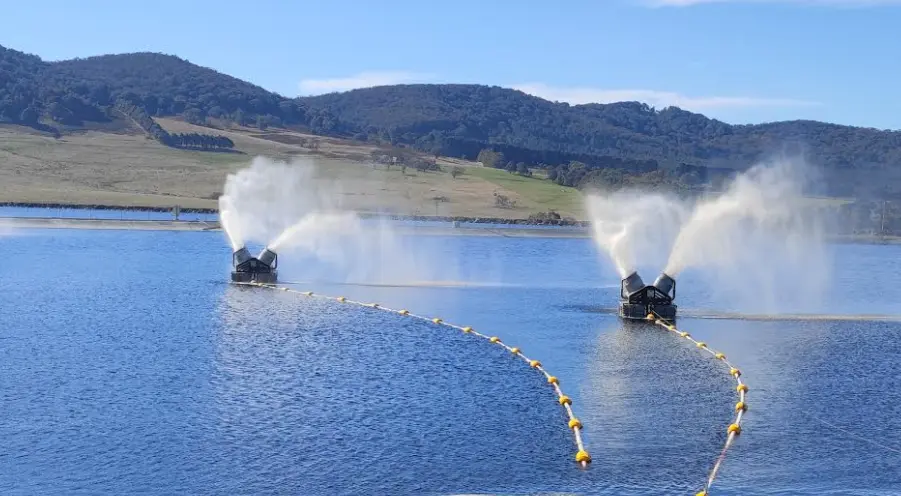Advanced technologies for mine water management.
L'évolution rapide du paysage de l'eau dans l'industrie minière a conduit à l'adoption d'une large gamme de technologies avancées de gestion de l'eau dans les mines. Ces solutions aident les sociétés minières à relever les défis réglementaires, opérationnels et environnementaux de manière rentable et durable. Vous trouverez ci-dessous un aperçu des technologies clés qui façonnent actuellement l'avenir de la gestion de l'eau dans les mines, ainsi que plusieurs approches supplémentaires qui n'ont pas été détaillées précédemment :
1. Mechanical evaporation with Minetek.
Technologie d'évaporation mécanique de Minetek change la donne en matière de gestion des eaux d'exhaure. Conçu selon les premiers principes de l'ingénierie des ventilateurs et de la circulation de l'air, avec des buses brevetées à faible encrassement et un flux d'air à grande vitesse, il traite l'eau avec des solides dissous totaux (TDS) et des solides en suspension totaux (TSS) élevés dans une plage de pH allant de 1,8 à 14. Contrairement aux bassins d'évaporation solaire, les systèmes Minetek sont mobiles, nécessitent un minimum d'entretien et fonctionnent efficacement sous divers climats, des hivers canadiens aux conditions arides de l'Australie. Ils traitent plus de 2 160 m³/heure et ne sont pas sensibles aux changements de qualité de l'eau d'alimentation. Le système de gestion de l'environnement (EMS) intégré surveille et réagit en temps réel aux changements de conditions environnementales tels que l'humidité, la pluie et le vent, en optimisant le fonctionnement en fonction d'un large éventail de paramètres réglables, notamment les heures optimales d'ensoleillement et d'arrêt, la vitesse et la direction du vent relatif, l'humidité et la température, le débit d'eau du système et la pression. Avec plus de 700 systèmes déployés dans 29 pays, la technologie Minetek permet de réduire les coûts jusqu'à 10 fois par rapport aux méthodes traditionnelles.
2. Passive treatment systems.
Les technologies de traitement passif utilisent des processus naturels pour assainir les eaux d'exhaure, en particulier pour le drainage minier acide (DMA). Les zones humides artificielles, les bioréacteurs anaérobies et les drains calcaires peuvent éliminer efficacement les métaux et neutraliser l'acidité avec un minimum d'énergie et de surveillance opérationnelle. Ces systèmes sont particulièrement utiles pour les sites miniers éloignés ou anciens, car ils permettent d'améliorer la qualité de l'eau à long terme et à faible coût.
3. Active water treatment plants.
Les stations de traitement actif conventionnelles utilisent des procédés physiques, chimiques et biologiques, tels que la clarification, la filtration, la précipitation, l'échange d'ions et l'osmose inverse, pour éliminer les contaminants de l'eau d'exhaure. Ces systèmes sont très efficaces en cas de chimie complexe ou variable de l'eau et sont souvent utilisés pour traiter l'eau en vue de son rejet ou de sa réutilisation, garantissant ainsi le respect de normes environnementales strictes.
4. Internet of Things (IoT) and big data.
Les systèmes de surveillance basés sur l'IdO améliorent la gestion de l'eau en fournissant des données en temps réel sur la qualité et les niveaux de l'eau. A Étude de 2023 sur la Chine démontre l'amélioration de l'efficacité du recyclage dans les mines de charbon, un modèle applicable aux États-Unis et au Canada. L'analyse avancée, la maintenance prédictive et les contrôles automatisés permettent d'optimiser le traitement de l'eau et la détection précoce des risques.
5. Water treatment and desalination.
Dans les régions où l'eau est rare, comme au Moyen-Orient, le dessalement et le traitement sont coûteux. Les systèmes d'évaporation de Minetek offrent une alternative rentable, réduisant la dépendance à l'égard des traitements chimiques. A 2025 Étude brésilienne met l'accent sur l'intégration du dessalement et de la réutilisation. En outre, les technologies de dessalement avancées, notamment l'osmose inverse, l'électrodialyse et l'osmose directe, sont de plus en plus utilisées pour convertir l'eau affectée par les mines en eau de traitement ou en eau potable.
6. Floating evaporators.
Pour les mines dont l'espace est limité, évaporateurs flottants offrent une solution compacte. Les systèmes flottants de Minetek maximisent l'efficacité, évaporant jusqu'à 50% du volume d'eau traité sous forme de vapeur d'eau pure, les gouttelettes restantes retournant dans l'étang, et aident à prévenir les dommages environnementaux en contenant l'eau toxique dans l'étang tout en garantissant la conformité. Alimentés par des moteurs électriques robustes et conçus pour traiter différentes capacités d'eau par minute, ils assurent une gestion complète et efficace de l'eau.
7. Underground mine water storage and backfilling.
Certaines exploitations minières utilisent des galeries souterraines abandonnées comme réservoirs de stockage contrôlé pour les eaux d'exhaure excédentaires ou dans le cadre d'opérations de remblayage à la pâte cimentée. Cette approche permet non seulement de gérer les volumes d'eau, mais aussi de contribuer à la stabilité du sol et de réduire le risque de déversement en surface.
8. Artificial recharge and Aquifer Storage and Recovery (ASR)
La recharge artificielle et l'ASR impliquent l'injection d'eau minière traitée dans les aquifères locaux en vue d'un stockage temporaire et d'une récupération ultérieure. Cette technologie gagne du terrain dans les régions où les exigences en matière de bilan hydrique sont strictes ou lorsque la disponibilité saisonnière de l'eau fluctue, ce qui permet aux mines de stocker l'eau excédentaire pendant les périodes humides pour l'utiliser en cas de sécheresse.

























